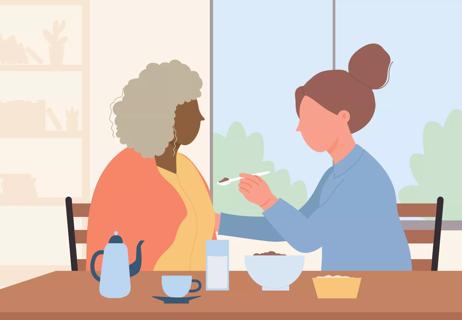Dairy, wheat, seafood, nuts and other foods may trigger inflammation

Eosinophilic esophagitis — a chronic allergic condition that causes inflammation in your esophagus — may be triggered by certain foods.
Advertisement
Cleveland Clinic is a non-profit academic medical center. Advertising on our site helps support our mission. We do not endorse non-Cleveland Clinic products or services. Policy
Should you try an eosinophilic esophagitis elimination diet?
Gastroenterologist Claire Beveridge, MD, explains how cutting out certain foods can help determine your problematic ones.
Yes. While environmental allergens (like pollen) can trigger eosinophilic esophagitis (EoE), certain foods may also trigger your EoE to be active. Symptoms related to EoE can be chest pain, heartburn and difficulty swallowing. An elimination diet may help you figure out your specific food triggers.
“About 70% to 80% of people will have their eosinophilic esophagitis controlled by doing a six-food elimination diet,” reports Dr. Beveridge. “Then, if your eosinophilic esophagitis is controlled, we can start reintroducing food groups to identify your food triggers. Most people have one to three food triggers, and the two most common are dairy and wheat.”
If you’re following an elimination diet to determine eosinophilic esophagitis food triggers, Dr. Beveridge says you typically need to eliminate the following six food groups:
Advertisement
An elimination diet should be followed under the guidance of a healthcare provider.
“The traditional approach is to do the full six-food elimination diet, where you take away all of those food triggers for at least six weeks,” explains Dr. Beveridge.
This is followed by an upper endoscopy. If your EoE is well managed, then you can add in food groups (one to two food groups at a time) every four to six weeks. With each food introduction, your healthcare provider will request an upper endoscopy with a biopsy to see if the eosinophils (a collection of white blood cells that cause inflammation) in your esophagus are controlled.
“If we see that there are elevated eosinophils and inflammation in the esophagus, then that food group is a trigger,” says Dr. Beveridge.
You keep going through this process of reintroducing food groups, as well as undergoing testing, until you’ve evaluated all six food groups.
In some cases, you can introduce multiple food groups at the same time, but Dr. Beveridge says there’s a caveat to this approach. For example, if you reintroduce seafood/shellfish and tree nuts/peanuts together and your test results show inflammation, then you have to separately reintroduce each food group to see which one is causing issues.
In addition, she notes that there are other approaches to the elimination diet. It’s also reasonable to start with a dairy and wheat elimination diet (a two-food elimination diet), as those two food groups are the most common triggers. The goal is to minimize the number of endoscopies and how restrictive the diet may be for you.
Is an elimination diet right for you? Consider the following:
Advertisement
Following an elimination diet for your eosinophilic esophagitis can help identify your food triggers. But it’s not a guarantee.
“An elimination diet may not get your EoE under control because you may have an environmental trigger as well,” clarifies Dr. Beveridge.
It’s vital that you know going in that this diet can be difficult to follow. And once you know what foods to avoid, eliminating a certain food group as you go through life can be a tall task.
“Identifying your food triggers isn’t just about minimizing certain foods, but completely eliminating them,” says Dr. Beveridge. “That’s what can make it really tricky and hard to follow — even a small amount of exposure to your food trigger can lead to inflammation.”
Advertisement
Learn more about our editorial process.
Advertisement

People with an inflamed esophagus may also have other conditions that cause a nagging, persistent cough

Forceful vomiting and stomach acid in your esophagus can cause a sore throat that lasts days or even weeks

What to know about dysphagia

Frequent burping can be many things — but likely not cancer

You have plenty of options to fill your belly, but caution is required when preparing meals

The conditions have similar symptoms, but are very different

Your body naturally produces the protein that’s essential for breaking down and digesting food

Nausea, fullness, heartburn and unexplained weight loss may signal that something is going on with your GI system

The ‘sunshine vitamin’ is found naturally in some fish and is added to other foods

Autism and ADHD often go hand in hand, giving rise to the term AuDHD

The Yuzpe regimen is less effective than other forms of emergency contraceptives, and it’s associated with more side effects